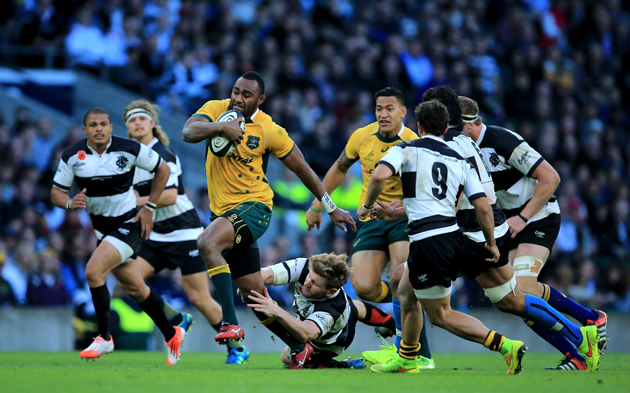From the offloading of Read and Sonny Bill to searing running lines in outside channels, the All Blacks are taking their attacking game to new heights
THIS IS it – the last chance for England to undermine New Zealand before the World Cup. To dent their psyche. As the sides prepare to launch the QBE autumn series on Saturday, the stats are daunting: only two NZ defeats in the 29 Tests since Steve Hansen took charge, and one of those had a mitigating factor – a sickness bug that left the All Blacks running on empty at Twickenham two years ago.
England are a better team now than then – but so are the All Blacks. It’s tempting to dismiss the Kiwis’ 74-6 canter in Chicago last week as an irrelevance. Tempting but wrong, because even against a second-tier nation like the USA there were lessons of shuddering value.
Having trained flawlessly in the week, the All Blacks dispatched the Eagles with an ease that other nations could only dream of. A couple of the dozen tries stemmed directly from the set-piece, but most entailed lethal execution from turnover ball. It was exhibition stuff and one hopes that most of the primetime TV audience appreciated what they were seeing, even if sporting slaughter doesn’t sit well with Americans.
You can watch all the tries on the video below. The last one (reel time 7:48) sums up what the All Blacks are about. Israel Dagg fields the ball 3m in from the right touchline near halfway and sends a long pass to Sam Cane in centrefield. Cane to Julian Savea to Dan Carter, who runs inside the USA 13, then passes outside to Victor Vito, who commits the last defender and delivers a back-of-hand offload to Savea to score. The move takes 13 seconds.
http://www.youtube.com/watch?v=ND9t63TUi98
Choosing the right angles
The try demonstrates the ability to strike quickly from counter-attack, awareness of space, the art of the offload and top support, Savea following his pass to score his 29th Test try.
Best of all, it features two ‘post’ lines, from a back (Carter) and a forward (Vito). By running an inward angle towards the posts, the defender is ‘fixed’ and the support player is given maximum space in which to work in the outside channel. It’s a basic skill and in no way exclusive to New Zealanders – for example, Gloucester’s Rob Cook did it beautifully to lay on a try for Jonny May against Leicester. But when it comes to doing the basics, nobody matches the efficiency of the Kiwis (and typically, the best example of a post line I saw last weekend came from a French-based Kiwi Nigel Hunt, who took out two Toulon players in setting up a try for Grenoble team-mate Robinson Caire).
Just as players must run a post angle when attacking the last man in space, so they should run a ‘flag’ angle when the attacker finds himself with an overlap but the defence already on top of him. In the video below, which shows highlights of a Hurricanes-Chiefs Super XV game, Chiefs wing Asaeli Tikoirotuma – now with Harlequins – has a ‘technical overlap’, with three attackers outside him faced by only two defenders (reel time 1:26).
But the two defenders are less than 2m away. If he runs straight, or inside on a ‘post’ angle before passing, he or his support runner will be tackled. There could even be an interception. So instead, Tikoirotuma runs towards the corner flag, committing both defenders to tackling him and offloading to his unmarked support before contact. Try time.
The full package
It’s this ability to execute that separates teams at the highest level. The All Blacks are deadly when they have an overlap, but they also have a knack of scoring when defences have numbered them off, such as the tries by Dane Coles (v South Africa) and Cory Jane (v Australia) at the tail-end of the Rugby Championship.
They ‘draw and pass’ better than opponents and they don’t worry if backs and forwards intermingle. In fact, Brodie Retallick is a major receiver (four times in the first ten minutes against the Boks in Wellington) whilst Kieran Read is the best offloader in the world – relegating Sonny Bill Williams to second place.
Throw in innovations like their passing in front of decoy runners, to eliminate the possibility of being penalised for obstruction, and you have one hell of an attacking package.
Big collisions in Cardiff
Ironically, whilst the artful Conrad Smith, a sumptuous footballer but not a powerhouse, will start at 13 for the ABs on Saturday, 130 miles west Wales and Australia will feature two bruisers at 13. Both nations have traditionally favoured guile over brawn in the back-line but in George North and Tevita Kuridrani you have a clash of the titans.
Each is 6ft 4in and over 16st. Both men, especially North, have a lot more than muscle to recommend them, but it’s a sign of the times that nifty footwork and a good outside break are increasingly expected to come in large packages. By way of comparison, John King, an England lock/No 8 killed in World War One, was 5ft 5in. How times change.
England, the third heavyweight in that ultimate Pool of Death for RWC 2015, may well have Sam Burgess – 6ft 5in and 18st 4lb – stationed in midfield by next September. The tremors may be felt beyond Twickenham.
All of which won’t bother New Zealand a jot. The world champions are doing very nicely as they are, thank you.






